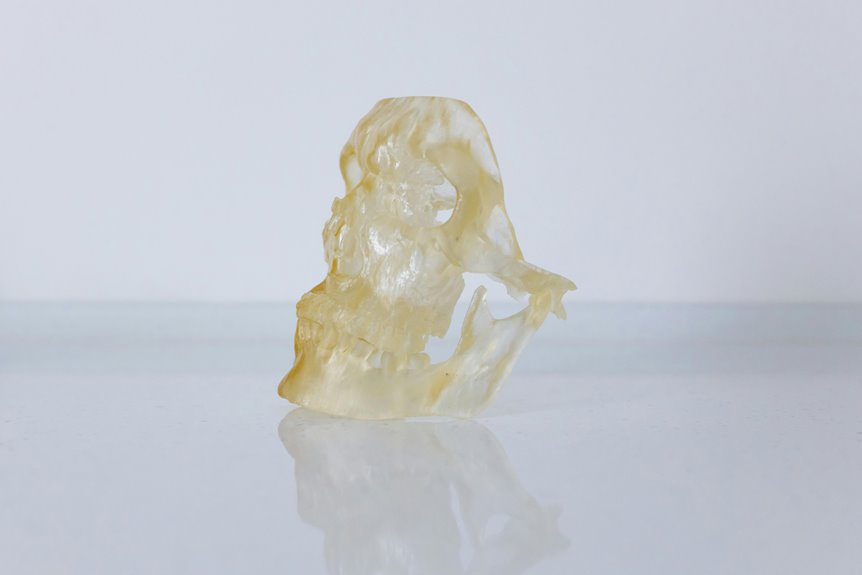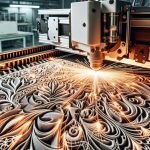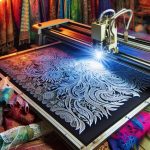SLS polyamide is a 3D printing method that uses a laser to fuse nylon powder layer by layer, creating strong, flexible parts without needing extra supports. You’ll appreciate its excellent durability, impact resistance, and ability to form complex shapes efficiently. This material is great for functional prototypes, custom medical devices, and lightweight automotive components. If you want to guarantee your designs meet printing guidelines and explore post-processing tips, there’s plenty to discover about this versatile technique.
Table of Contents
Key Takeaways
- SLS Polyamide uses a laser to sinter nylon powder layer by layer, creating strong, durable 3D printed parts without support structures.
- Polyamide (nylon) offers excellent strength, flexibility, impact resistance, and chemical durability, ideal for functional prototypes and end-use parts.
- Design parts with 0.8–1 mm minimum wall thickness and self-supporting angles to optimize printing quality and part durability.
- Proper powder storage, controlled build chamber temperature, and laser settings are essential to prevent warping, clumping, and incomplete fusion.
- Post-processing includes powder removal, bead blasting, polishing, and sealing to enhance surface finish and part longevity.
Understanding Selective Laser Sintering Technology
Selective Laser Sintering (SLS) uses a powerful laser to fuse powdered material layer by layer, building your 3D object from the ground up.
You start by spreading a thin layer of powder across the build platform. The laser then selectively sinters, or heats, the powder according to your design’s cross-section.
Once a layer is complete, the platform lowers slightly, and another powder layer is spread. This process repeats until your object is fully formed.
Because the unsintered powder supports the part during printing, you don’t need additional support structures, allowing for complex geometries.
SLS works with various materials, but the key is its precision and ability to create strong, functional parts.
You’ll appreciate how efficient and versatile this technology is for prototyping and production.
What Is Polyamide and Its Properties
The laser sintering process relies heavily on the materials it fuses, and polyamide stands out as one of the most popular choices.
Polyamide, commonly known as nylon, is a type of thermoplastic polymer prized for its strength, flexibility, and durability. When you work with polyamide in SLS printing, you benefit from its excellent mechanical properties, including impact resistance and good fatigue endurance.
Polyamide offers strength, flexibility, and durability with excellent impact resistance and fatigue endurance in SLS printing.
It also offers a relatively low melting temperature, making it ideal for efficient sintering. Additionally, polyamide is lightweight and has a smooth surface finish after printing.
Its natural resistance to chemicals and moisture guarantees the parts you create perform well in various environments. Understanding these properties helps you select the right material for your SLS projects and achieve reliable, high-quality results.
Advantages of Using Polyamide in SLS Printing
When you choose polyamide for SLS printing, you get a material that’s both durable and strong, perfect for tough applications.
It also offers great flexibility and impact resistance, so your parts can handle stress without cracking.
Plus, it’s cost-effective and efficient, helping you save time and money on production.
Durability and Strength
Durability plays an essential role in choosing materials for 3D printing, and polyamide shines in this aspect. When you use SLS polyamide, you get parts that resist wear, heat, and chemicals, making them reliable for demanding applications. You’ll appreciate how the material maintains strength over time without cracking or deforming.
Here’s a quick look at polyamide’s durability and strength features:
| Property | Polyamide (Nylon) | Typical Alternative |
|---|---|---|
| Tensile Strength | 48 MPa | 35 MPa |
| Heat Resistance | Up to 180°C | Around 120°C |
| Chemical Resistance | High | Moderate |
With these qualities, you can confidently choose polyamide for sturdy, long-lasting 3D printed parts.
Flexibility and Impact Resistance
Although you might prioritize strength, flexibility and impact resistance are just as essential for many 3D printing projects.
SLS polyamide offers a unique balance, letting your creations absorb shocks without cracking or breaking. This means your parts can endure unexpected drops or bending forces, making them perfect for functional prototypes and end-use components alike.
You’ll appreciate how polyamide’s flexibility lets you design complex shapes that move or flex naturally under stress.
Here’s why you’ll love using SLS polyamide for these qualities:
- Withstand repeated impacts without damage
- Flex slightly to avoid fractures
- Maintain shape after bending or twisting
- Absorb shocks during real-world use
- Create durable yet adaptable parts
This flexibility combined with impact resistance gives your projects resilience and reliability.
Cost-Effectiveness and Efficiency
Since managing production costs is essential, SLS polyamide stands out by combining affordability with high performance. You’ll save money because PA powders are reasonably priced and reusable, reducing material waste. Plus, SLS printing with polyamide doesn’t require support structures, speeding up production and lowering labor costs. This efficiency means you can produce complex parts faster without compromising quality.
| Factor | Benefit | Impact on You |
|---|---|---|
| Material Cost | Affordable PA powders | Lower raw material expenses |
| Reusability | Unused powder recyclable | Minimizes waste and cost |
| No Support Needed | Simplifies post-processing | Speeds up production |
Common Applications of SLS Polyamide Parts
SLS polyamide parts excel in a variety of industries because they combine strength, flexibility, and detailed resolution. When you choose SLS polyamide, you tap into a world of possibilities where precision meets durability.
You’ll find these parts thriving in applications that demand both toughness and intricate design.
Here are some common uses where SLS polyamide truly shines:
- Functional prototypes that need to withstand real-world testing
- End-use production parts for small to medium runs
- Custom-fit medical devices and orthotics tailored to you
- Lightweight automotive components that boost efficiency
- Complex aerospace parts requiring heat resistance and strength
With SLS polyamide, you get versatile parts ready to meet your toughest challenges.
Preparing Your 3D Model for SLS Polyamide Printing
Before printing with SLS polyamide, you’ll need to adjust your 3D model to meet specific design guidelines.
Make certain your file is saved in the correct format and check that wall thicknesses are optimized for strength and detail.
These steps help guarantee your print comes out strong and accurate.
Model Design Considerations
When preparing your 3D model for polyamide printing, you’ll want to account for factors like wall thickness, feature resolution, and support structures.
Designing with SLS polyamide means balancing strength and detail without overcomplicating the print. Keep these essentials in mind:
- Guarantee minimum wall thickness (usually 0.8–1 mm) for durability
- Avoid tiny features that can get lost or break easily
- Design self-supporting angles; SLS doesn’t need traditional supports
- Incorporate escape holes for powder removal in enclosed parts
- Optimize part orientation to reduce print time and improve surface finish
File Format Requirements
Although preparing your 3D model for polyamide printing involves careful design, choosing the right file format is just as essential to guarantee a smooth printing process.
You’ll want to save your model in formats widely accepted by SLS machines, like STL or OBJ. STL files are the industry standard and store surface geometry efficiently, but OBJ files can include color and texture data if needed.
Make sure your file is watertight, meaning it has no holes or non-manifold edges, as these issues can cause print failures. Double-check your model’s scale and orientation before exporting.
Avoid proprietary formats that mightn’t be compatible with your printer’s software. By selecting the appropriate file format and preparing it correctly, you’ll set yourself up for a successful SLS polyamide print.
Optimizing Wall Thickness
Since wall thickness directly impacts both the strength and print quality of your SLS polyamide parts, you need to optimize it carefully.
Too thin, and your part risks breaking or warping; too thick, and you waste material and increase print time. Aim for a balanced wall thickness that fits your design’s function and detail level.
Keep these tips in mind to nail your wall thickness:
- Guarantee a minimum of 1 mm thickness for durability
- Avoid exceeding 5 mm to prevent overheating and warping
- Adjust thickness based on part size and load requirements
- Use uniform wall thickness to reduce stress points
- Test prototypes to find the perfect balance before final prints
Optimizing wall thickness guarantees your parts come out strong, precise, and cost-effective every time.
Best Practices for Printing With PA Powders
Mastering SLS printing with PA powders requires careful control of powder handling, printing parameters, and post-processing steps. You should store powders in a dry, sealed container to prevent moisture absorption. Use consistent layer thickness and ideal laser power to guarantee fusion without degradation. Monitor build chamber temperature closely to avoid warping.
| Best Practice | Reason |
|---|---|
| Store powders dry | Prevents clumping and poor sintering |
| Enhance laser power | Guarantees strong, precise layer fusion |
| Control build temp | Minimizes warping and internal stresses |
Post-Processing Techniques for SLS Polyamide Prints
When you finish printing your SLS polyamide parts, cleaning up and refining them is essential to achieve the best results.
Post-processing not only enhances aesthetics but also improves durability and functionality. Start by removing excess powder with compressed air or a soft brush.
Post-processing boosts both the look and strength of your parts, starting with powder removal using compressed air or a soft brush.
Next, use bead blasting to smooth surfaces gently. If you want a glossy finish, try tumbling with polishing media. For stronger parts, consider applying a sealant or dye to improve color and resistance.
Finally, inspect your parts carefully for any imperfections or weak points.
Here are key post-processing techniques to try:
- Powder removal with compressed air
- Bead blasting for surface smoothing
- Tumbling to polish and shine
- Applying sealants for durability
- Dyeing for vibrant colors
These steps bring your SLS prints to life!
Comparing SLS Polyamide With Other 3D Printing Materials
Although SLS polyamide offers excellent strength and flexibility, it’s important to weigh its benefits against other 3D printing materials to choose the best fit for your project.
Compared to FDM filaments like PLA or ABS, SLS polyamide delivers superior mechanical properties and durability, making it ideal for functional parts.
Unlike resin-based SLA prints, SLS parts don’t require extensive support structures, saving you time during post-processing.
However, SLS machines tend to be pricier and less accessible than FDM printers.
If your priority is fine detail or smooth surface finish, SLA might be a better choice.
Meanwhile, materials like TPU offer more elasticity, but lack SLS polyamide’s rigidity.
Troubleshooting Common Challenges in SLS Polyamide Printing
Since SLS polyamide printing involves precise temperature control and powder handling, you might encounter issues like warping, incomplete fusion, or surface roughness. Tackling these challenges is essential for achieving high-quality prints.
Here’s how you can troubleshoot common problems:
- Warping: Confirm the build chamber temperature is stable and preheat the powder bed properly.
- Incomplete Fusion: Check laser power and scanning speed to assure full sintering.
- Surface Roughness: Use fresh powder and optimize layer thickness for smoother finishes.
- Powder Clumping: Maintain powder humidity and regularly sift to keep it flowable.
- Build Failure: Design parts with adequate support and avoid sharp corners to reduce stress concentration.
Frequently Asked Questions
How Does SLS Polyamide Impact Environmental Sustainability?
You reduce waste by reusing unused powder in SLS polyamide printing, which lowers material consumption. Plus, its energy-efficient process and recyclable materials help you support environmental sustainability compared to traditional manufacturing methods.
What Are the Safety Precautions When Handling PA Powders?
You should always wear gloves, a mask, and safety goggles when handling PA powders to avoid skin contact and inhalation. Work in a well-ventilated area and clean spills promptly to maintain safety and prevent contamination.
Can SLS Polyamide Prints Be Recycled or Reused?
You can recycle SLS polyamide prints by grinding and reusing powder in new print jobs, but over time, material degrades. Always mix used powder with fresh powder to maintain quality and guarantee successful prints.
What Is the Cost Comparison Between SLS Polyamide and Other Materials?
Imagine choosing between a sturdy, reliable car and a flashy sports model. SLS polyamide costs less than metals but more than basic plastics—you’ll find it balances durability and price, making it a smart, versatile investment for your projects.
Are There Any Health Risks Associated With SLS Polyamide Dust Inhalation?
You should avoid inhaling SLS polyamide dust, as it can irritate your respiratory system. Wearing proper masks and ensuring good ventilation helps minimize risks. Always follow safety guidelines to protect your health while handling powders.
- Corduroy Blazer: Perfect Fabric Choice for Holiday Parties - July 3, 2025
- Is Corduroy Warm? Discover Its Cozy Qualities and Benefits - July 3, 2025
- Cutting Corduroy Pants Into Stylish Shorts: a Step-By-Step Guide - July 3, 2025







